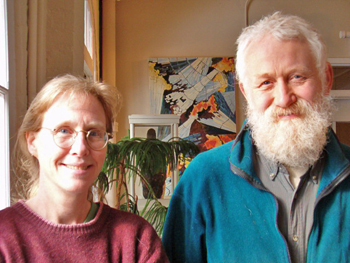ESSC 100
 Taught by: Jeff Walker and MaryAnn Cunningham
Taught by: Jeff Walker and MaryAnn Cunningham
The Course
What is the course in which you use instructional technologies about? Tell us about its origin, goals and objectives.
Mary Ann: The course is Food and Farming and it is part of the curriculum of the Earth Science and Society program. The first time we taught the class it was a 100-level course and then we modified it to be at the 200-level.
Jeff: Our goals were to provide an integrated multidisciplinary course that includes physical parameters and the social and policy aspects of agriculture. This is the context of Earth Science and Society, to combine a geologist and a geographer to teach key courses. Two other classes part of the ESSC curriculum include Water and Cities and Carbon Conflicts. ves or perhaps exacerbates problems of representation.
The Technology
What were the technologies used and how did they change or enhance your course?
Mary Ann: We used the agriculture census data, which we can map with ArcGIS software to look at distributions of crop-growing regions. The agricultural census is one of the most important data sources we have concerning land use and agricultural production. We identified regions in the U.S. and had the students explore the crops and the major subsidies that supported those crops.
Jeff: This gave the students a country-wide view of agriculture. For instance, ‘Where’s the farm belt? Where are the pigs?’
Then they used physical parameter modeling programs to explore their regions. The students used WebWIMP (Web-based, Water-Budget, Interactive, Modeling Program) to create a water budget and help explain seasonality of different areas. There’s a lot of geographic information in the model on this web site that you don’t really see. The students model a change in temperature or rainfall in increments and see the results. It’s very powerful.
Mary Ann: The students also model physical conditions using a nutrient cycle animation that came with their textbook, and that models incremental changes in climatic parameters like temperature, weathering rate, and nutrient uptake. They try to replicate and predict where the nutrients are stored — so they’re focused on nutrients in biomass, soil, and litter.
The Student Response
How have your students responded to your use of this technology?
Jeff: The students responded well, they were sort of typical as in any class. Some are very into it from the beginning and others go at it slowly. Using GIS and the agriculture census can be overwhelming at first, but Mary Ann’s there to bail us out.
Mary Ann: We used these models frequently during the course. The advantage of the models is that students quickly begin talking about the details of the problems; they’re not talking about the subject in vague generalizations. In the end they all make good use of the various models that they are using.
The Challenges
What were the challenges you faced when teaching this course?
Jeff: For me, I wasn’t used to using the agriculture census, and I find GIS challenging because it is like thinking in four dimensions.
Mary Ann: There’s a bit a learning curve. We all need to be patient.
Jeff: When you first look at the nutrient cycle model, it looks a little cheesy. But really it is quite sophisticated. The students have to work very methodically and the simplicity of the program becomes a virtue.
New Directions
What new directions would you like to explore with technology in your teaching?
Mary Ann: This past fall semester we used the same web sources as the first time we used them. In other contexts we could use some climate circulation models.
There are lots of canned models on the web that are great to use, great for visualizations. Many of these on-line models I will explore for this class or others.
We also added to the class reading the new Farm Bill, from thomas.gov. With over 600 pages in the Bill, we asked the students to use PDF mark-up software to make notations and comments, and then we projected the bill text, with their markup and annotation, for class discussion.
